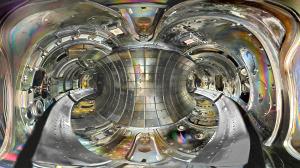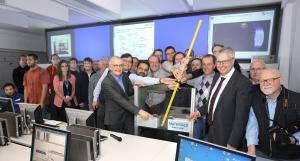TEXTOR was primarily built and used to study the interactions between plasma and the vacuum vessel wall. With respect to plasma temperature and plasma density, the experiment was unable to reproduce the real operating conditions of a fusion power plant. TEXTOR was too small to do so. The device was also not suitable for exploring the problems associated with continuous operation. "And yet continuous operation is the remaining hurdle on the way towards a fusion power plant for electricity generation. Now that TEXTOR has been shut down, we will direct our full attention to overcoming this challenge," says Samm.
Jülich plasma physicists emphasized the new focus on the altered issues with a symbolic act. Yesterday, after TEXTOR's last plasma discharge, they pushed a button in its control centre: the control monitors then no longer showed the interior of the TEXTOR vacuum vessel, but images of the Jülich plasma generator PSI and other materials research set-ups. After all, the continuous operation of a fusion power plant will only be possible if suitable materials are available.
Jülich fusion researchers have been preparing for the shift in their research priorities for quite a while. For example, in March of this year, Forschungszentrum Jülich appointed Prof. Christian Linsmeier from the Max Planck Institute for Plasma Physics, Garching—an acclaimed materials researcher—second director of the subinstitute. In addition, the plasma physicists have been expanding their research activities outside of TEXTOR: at the very end, only 15 percent of the laboratory space was dedicated to the large-scale device. Jülich fusion researchers will also continue to work at international and European installations, particularly at the largest existing fusion experiment—JET in the UK. In addition to ITER and DEMO, the reactor generation after ITER, they are putting their expertise to good use at the Wendelstein 7-X stellarator in Greifswald—an alternative reactor type.
The dismantling of TEXTOR, which contains some 600 tonnes of metal, will take more than three years.



